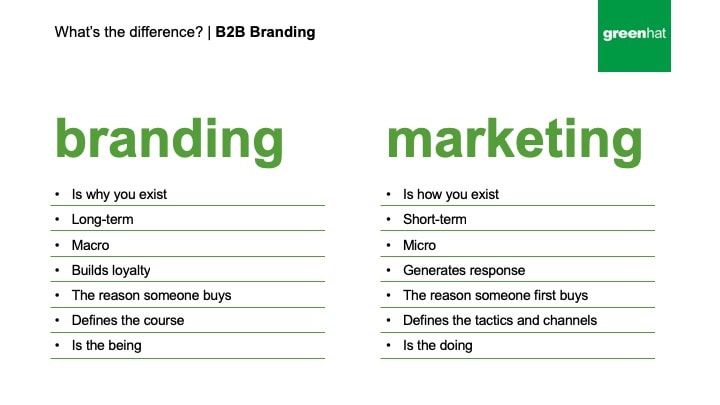How to take your CEO on the journey to build best-in-class marketing
Close your eyes for a moment and pick three brands you truly admire. What can you see? Is it the inspired offering or the reality of what you receive? What is it that makes this selection so very memorable to you? Is it an outstanding and thought-provoking creative marketing campaign? Is the brand in your head or in your heart? Is the brand identity unmistakable? Now, is that brand B2B … probably not, but it doesn’t have to be that way.
Now, look here…
The way customers use and recognise products and services has changed, but more often than not branding hasn’t kept up. If brands have a challenge with market positioning, it’s often the brand and its inability to win hearts and minds that are causing the issue.
Perhaps it’s because of the immediate message-and-measure marketing efforts versus the perceived cosmetic necessity of branding that makes the branding process so tough to digest. This is okay if you test, review and learn from your errors, but I’m picking the brand that isn’t on the radar as the crux of the problem.
Let me start by differentiating marketing from branding.
The difference between branding and creative marketing

While not mutually exclusive, the holistically considered brand is essential to ensure it is marketed effectively – and it’s not simply the logo. It’s the intention of the complete experience to your audience.
Brands and creativity will be the major drivers of corporate value for brands in the 21st century. Brand Strategy Insider
Marketing relies on the sales funnel – often surgically inserted between the eye sockets of most marketers. It’s a great guide and ensures marketers know where their audience is at every stage of the buying process, as well as driving how to communicate and connect at each touchpoint of the customer’s journey. Often the brand simply comes along for the ride.
Branding is not an immediately measurable component, which is why implementing a brand strategy and allocating budget is so hard to communicate to the boss and the number crunchers.
Brand influences the value perceived by a consumer. Brand can drive growth in the market, and it can win market share. Brand is at the heart, of what an organization does. It should drive everything a company does, and it is also the effect of what an organization does, not just the cause.
Brand can change the way we think, feel and act towards an organization, and it is important that the whole experience a customer feels and engages with a brand is designed. This means every touchpoint must be considered, including a sales activation campaign: “How is your brand being presented in this campaign?” What does creative brand alignment really mean to your organisation?
Even in a direct response campaign, it is important to consider how a brand is being represented across every channel. Striking the right balance between sales activation and brand awareness will result in greater campaign effectiveness.
Five elements for brand connectivity (or blindside branding because it sounds better)
Okay, not quite that harsh, but influencing human behaviour to make certain purchase decisions is a fine mix of content and brand.
Mixing these five key elements with an always-on brand and marketing strategy will assist you to be subconsciously contemplated by your audience:
1. Be consistent:
Let’s face it, managing one brand can be tiresome to the point where you stare at the same style day in, day out – so the odd one-off tweak won’t matter, will it? Actually, yes, it will, and you could be opening a can of worms. Your savvy customers will notice and you could lose confidence and credibility.
A great deal of effort goes into a brand style guide (unfortunately, it’s a pain in the corporate wallet because it’s not a measurable expense). Many guides are not prepared with ease of accessibility, or with a variety of suppliers in mind (the best brand guides are online). They can be either too regimented or so loose that the brand guardian’s eye can wander and govern communication, which may not resonate with the audience and thus cause a complete customer disconnect.
Policing a brand is a big responsibility. Those with the responsibility of guardianship can easily lose sight of how important it is to look consistent. Don’t let boredom overshadow the value of consistency. Unless there is a communication issue to be solved or it’s time for a refreshing overhaul, place that tinkering instinct elsewhere.
2. Be Cohesive:
The audience must realise that you understand their needs. Sprinkle in a unique tone and manner with clear communication and the audience will know it’s you each time.
3. Be Relevant:
In order to be interesting to the consumer, you need to understand their point in the evolution cycle with your product/service. Being front-of-mind in a timely manner will keep your brand on the consideration list.
4. Be Distinctive:
Often the most difficult. Be honest. What makes your brand appear unmistakably different from your competitors? Is it how you look? That unique style? That distinctive way you communicate to your audience? It’s never been more critical to understand brand point-of-difference and what it means to the internal and external audience. Try not to get blindsided by a good idea and lose sight of your brand identity. That said, don’t let great ideas pass you by, just make sure you carry that distinctive brand thread.
5. Be Memorable:
Another ultimate challenge, which should be defined in every creative briefing. Aside from people, what is it that makes your brand positively memorable? Now, what is it that makes your marketing positively memorable? If you can plant a finger on both, that’s the measure of brand success. There is a plethora of creative brand tactics to influence perception and gain retention, from Mneumonics to Gestalt principles.
Help your agency understand your brand strategy
Harsh I know, but if you’re not giving your agency a good grasp on your brand strategy you are setting any creative up to fail.
Why? Because B2B buyers are concerned with the vitality and longevity of the brands behind the products they buy.
For a B2B decision-maker, choosing a product goes well beyond considerations of features, saving time, and price. If you can receive the respect your brand deserves and deliver on the expression of the brand values, you are well placed to lead to that intent zone in the funnel.
A purchase choice in B2B represents a commitment. This amplifies the importance of the company brand behind the product or service.
Eyes wide shut or eyes on the prize?
It’s more important than ever to build trust with a team of experts who understand your brand strategy and marketing objectives. Despite the shift to in-house branding teams, it’s important to give trusted suppliers the opportunity to provide an outside lens.
How your brand presents to the audience with holistic omnichannel thinking will set you up for success to provide relevant, memorable and fresh ideas to keep your brand in the line of sight. Who knows, you may even get some confidence to really raise some eyebrows!
P.S. Look at me, look away, look at me again…
It’s a no brainer that when your brand switches off, awareness levels drop and you lose the front-of-mind position that your last campaign tried so hard to achieve – unless you create a campaign which gets chins wagging so much so that it outlasted your quarterly budget. It’s not plain sailing selling a long-term and always-on brand presence with the CFO, but there is certainly value in this approach – but that’s another blog.
There is a great deal more to branding than meets the marketing eye. Why not reach out and chat to the brand experts at Green Hat to discuss how to get more eyes on your B2B brand.
.png)
 Brand
Brand Strategy
Strategy Creative & Content
Creative & Content






